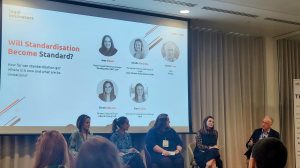Legal Innovators conference in London, created by Artificial Lawyer, seems to be the go-to conference for those interested in the development of our future legal services. The conference room was packed with delegates and in the directly adjoining area there were lots of exhibitors wanting to showcase their solutions.

Instead of highlighting cool tech solutions and inspirational presentations of ideas around projects that will never work in practice, this conference was about actual change and about improved delivery of legal services in practice. It could also be described as two days about business development discussions. Day one focused on the private practice and day two on in-house counsels. This report from the event focuses on the first day.

At this event we could for example find Chrissie Lightfoot, a leading woman in Legal Tech and author of “The Naked Lawyer”.
Zach Abramowitz, founder of Killer Whale Strategies, kicked off the conference energetically stating that efficiency is for amateurs. Now legal tech is more about talent retention, how to get more business and how to receive a competitive edge. Therefore, we need to move on to building much better solutions, which is a subject we need to come back to.
During the whole first day it was obvious that document assembly tools are considered as a necessity within law firms and part of all kinds of projects; for helping clients to digitalize, to automate client templates or to use for inhouse efficient work. When it comes to business development in this sector, there is a lot of focus on the documents. Michael Bjerg Hansen, Co-founder and CEO of Green Meadow, stressed that when it comes to document automation many still seems to believe it is about 90% process and 10% content, when in reality it is the opposite. It is about 90% content and therefore it is crucial to here involve experienced lawyers that must agree to produce the content. This means we need to talk about standardization.

The most interesting discussion this first day was around standardization. It was a panel moderated by Martin Coen, CEO of Opus2 and included Amelia Slocombe, Managing Director and Head of Legal at Loan Market Association (LMA), Shruti Ajitsaria, Partner and head of Fuse at Allen & Overy, Amy Moore, Digital Legal Delivery Manager at Gowling WLG and Sara Collins, Director of Legal Services Design at NRF. Considering that when building document automation tools, 90% is about the content, it is crucial to standardize our writings. This is also the core problem with standardization in the legal sector. Many lawyers believe their comparative advantage lies in how they use their words, i.e. that their intriguing way of formulating their clauses etc. make them stand out of from their competitors. Therefore, the big problem here is to make these lawyers give up some of their obsession with words. This is an interesting view of the obstacles for standardization. Lawyers need to learn to accept wordings that are not perfect, if the changes they would like to propose do not have any material effect. That seems to be the key to developing standards. If lawyers cannot agree on the content, on the wordings in the documents, it is quite impossible to proceed with the digitalization of the whole process.
There were also some panel discussions regarding innovations in law firms. Innovation within law firms seems to focus mainly around four different areas:
- Client projects
- Developing online products aiming towards several clients
- Internal efficiencies
- Helping clients to choose tech solutions
 Kerry Westland, Partner at Addleshaw Goddard, stressed the importance of not using old business models on the innovation department since that might kill innovation. She wants innovation to be open-minded without any need for initial ROI since many projects ends up completely different from what was described in the beginning. If you can involve a client in an innovation project where you really focusing on this client need, this is a great opportunity for building even better relationships with this client. One important argument for building client solutions, is to win high value business. During the day it was stressed that law firms are in many cases expected to support their clients to manage low value work to be able to get the high value work.
Kerry Westland, Partner at Addleshaw Goddard, stressed the importance of not using old business models on the innovation department since that might kill innovation. She wants innovation to be open-minded without any need for initial ROI since many projects ends up completely different from what was described in the beginning. If you can involve a client in an innovation project where you really focusing on this client need, this is a great opportunity for building even better relationships with this client. One important argument for building client solutions, is to win high value business. During the day it was stressed that law firms are in many cases expected to support their clients to manage low value work to be able to get the high value work.
Here is the report of the second “in-house day” of the conference: Legal Innovators In-House Day

